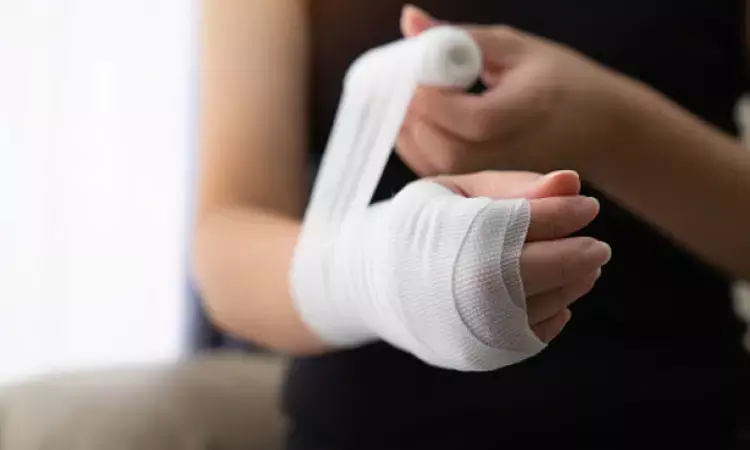- Home
- Medical news & Guidelines
- Anesthesiology
- Cardiology and CTVS
- Critical Care
- Dentistry
- Dermatology
- Diabetes and Endocrinology
- ENT
- Gastroenterology
- Medicine
- Nephrology
- Neurology
- Obstretics-Gynaecology
- Oncology
- Ophthalmology
- Orthopaedics
- Pediatrics-Neonatology
- Psychiatry
- Pulmonology
- Radiology
- Surgery
- Urology
- Laboratory Medicine
- Diet
- Nursing
- Paramedical
- Physiotherapy
- Health news
- Fact Check
- Bone Health Fact Check
- Brain Health Fact Check
- Cancer Related Fact Check
- Child Care Fact Check
- Dental and oral health fact check
- Diabetes and metabolic health fact check
- Diet and Nutrition Fact Check
- Eye and ENT Care Fact Check
- Fitness fact check
- Gut health fact check
- Heart health fact check
- Kidney health fact check
- Medical education fact check
- Men's health fact check
- Respiratory fact check
- Skin and hair care fact check
- Vaccine and Immunization fact check
- Women's health fact check
- AYUSH
- State News
- Andaman and Nicobar Islands
- Andhra Pradesh
- Arunachal Pradesh
- Assam
- Bihar
- Chandigarh
- Chattisgarh
- Dadra and Nagar Haveli
- Daman and Diu
- Delhi
- Goa
- Gujarat
- Haryana
- Himachal Pradesh
- Jammu & Kashmir
- Jharkhand
- Karnataka
- Kerala
- Ladakh
- Lakshadweep
- Madhya Pradesh
- Maharashtra
- Manipur
- Meghalaya
- Mizoram
- Nagaland
- Odisha
- Puducherry
- Punjab
- Rajasthan
- Sikkim
- Tamil Nadu
- Telangana
- Tripura
- Uttar Pradesh
- Uttrakhand
- West Bengal
- Medical Education
- Industry
Immobilization below or above elbow equally effective in patients with radius fracture

The findings of a study published in the Chinese Journal of Traumatology suggest that while both immobilizations above and below elbow results in similar functional and radiological outcomes for the conservative treatment of distal end radius fractures in adults, while the latter is associated with a lower rate of shoulder pain.
The team led by Vikash Raj wanted to determine the difference in the type of immobilization (above elbow vs. below elbow) in the conservative treatment of distal end radius fractures in adults. The study was performed using a systematic review of the available literature and meta-analysis. The authors searched several electronic databases, including Medline, Embase, Ovid, and Cochrane, for relevant randomized clinical trials.
The highlights of the study were:
The authors found 6 randomized clinical trials that met the inclusion criteria and were suitable for quantitative review. The meta-analysis revealed high heterogeneity among the studies, but no difference between the two types of immobilization in terms of functional and radiological scores.
The standard mean difference between the disability of the arm, shoulder and hand scores in both groups was 0.52 (95% CI (-0.28)-1.32), which was not statistically significant.
Similarly, no statistical differences were found in radial height, radial inclination, palmar tilt, and ulnar variance.
Shoulder pain occurred more commonly as a complication in the above elbow immobilization group and the difference was statistically significant (above elbow: 38/92, 41.3%; below elbow: 19/94, 20.2%).
This study provides important information for medical professionals and patients who are considering conservative treatment options for distal end radius fractures. Further research is needed to better understand the implications of these results and to make evidence-based recommendations for the treatment of distal end radius fractures.
Reference:
Raj, V., Barik, S., & Richa. (2022). Comparison of above elbow and below elbow immobilisation for conservative treatment of distal end radius fracture in adults: A systematic review and meta-analysis of randomized clinical trials. In Chinese Journal of Traumatology. Elsevier BV. https://doi.org/10.1016/j.cjtee.2022.12.005
Neuroscience Masters graduate
Jacinthlyn Sylvia, a Neuroscience Master's graduate from Chennai has worked extensively in deciphering the neurobiology of cognition and motor control in aging. She also has spread-out exposure to Neurosurgery from her Bachelor’s. She is currently involved in active Neuro-Oncology research. She is an upcoming neuroscientist with a fiery passion for writing. Her news cover at Medical Dialogues feature recent discoveries and updates from the healthcare and biomedical research fields. She can be reached at editorial@medicaldialogues.in
Dr Kamal Kant Kohli-MBBS, DTCD- a chest specialist with more than 30 years of practice and a flair for writing clinical articles, Dr Kamal Kant Kohli joined Medical Dialogues as a Chief Editor of Medical News. Besides writing articles, as an editor, he proofreads and verifies all the medical content published on Medical Dialogues including those coming from journals, studies,medical conferences,guidelines etc. Email: drkohli@medicaldialogues.in. Contact no. 011-43720751


